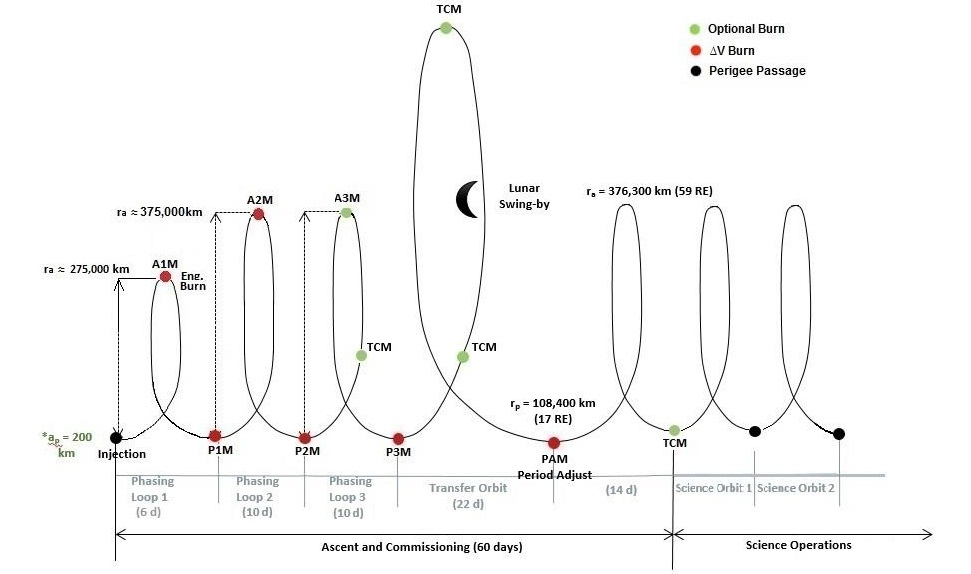Комментарии 15
У Радиоастрона перигей 600 км, ну и апогей чуть пониже. А так орбиты одинаковые :)
Википедия думает по другому
КРТ обращается по эллиптической орбите с высотой апогея около 340 тыс. км[8], сравнимой с расстоянием до Луны, и использует лунную гравитацию для поворота плоскости своей орбиты.
Не сразу дошло, перигей и правда 600 км, сорри.

Стабильная орбита, на которой Земля не заслоняет значительную часть сферы и не усложняет систему охлаждения аппарата (нет ни тени, ни переотражения тепла от планеты). Периодические сближения упрощают передачу данных.
https://www.nasa.gov/content/goddard/new-explorer-mission-chooses-the-just-right-orbit
To carry out an exhaustive two-year survey of extrasolar planets in both celestial hemispheres, TESS needed to occupy a very particular position in space, a highly stable place that maximized sky coverage and gave the observatory a mostly unobstructed view of the cosmos, all from a low-radiation, thermally benign environment.… lunar-resonant orbit known as P/2
https://en.wikipedia.org/wiki/Transiting_Exoplanet_Survey_Satellite
The highly elliptical orbit has a 373,000 km (232,000 mi) apogee, timed to be positioned approximately 90° away from the position of the Moon to minimize its destabilizing effect. This orbit should remain stable for decades, and will keep TESS's cameras in a stable temperature range. The orbit is entirely outside the Van Allen belts to avoid radiation damage to TESS, and most of the orbit is spent far outside the belts. Every 13.7 days at its perigee of 108,000 km (67,000 mi), TESS will downlink the data it has collected during the orbit to Earth over a period of approximately three hours.[17]
https://tess.gsfc.nasa.gov/documents/tess_factsheet_06-05-15.pdf
Unobstructed view for continuous light curves… Thermally stable and low-radiation
https://arxiv.org/pdf/1406.0151.pdf
the use of a high-Earth elliptical orbit, which provides a more stable platform for precise photometry than the low-Earth orbit that had been the basis of all the previous proposals.… Since the brightest stars are nearly evenly distributed over the entire sky, this desire led in the direction of an all-sky survey.… 3.8 Orbit. The ideal orbit for the TESS spacecraft would allow for continuous observations lasting for weeks, and would be stable to perturbations over the multi-year duration of the survey. It would offer a low-radiation environment, to avoid high trapped-particle fluxes and resulting degradation of the CCDs and flight electronics. It would also offer a stable thermal environment and minimal attitude disturbance torques, to provide a stable platform for precise photometry. The orbit would be achievable with a moderate ∆V, avoiding the need for a costly secondary propulsion unit. Furthermore, to facilitate data transfer, the spacecraft would be close to the Earth during at least a portion of the orbit.… The TESS orbit is inclined from the ecliptic plane, thereby eliminating lengthy eclipses by the Earth and Moon… The orbit remains above the Earth’s radiation belts, leading to a relatively low-radiation environment with a mission total ionizing dose of <1 krad. The nearly constant thermal environment ensures that the CCDs will operate near −75◦C, with temperature variations <0.1 ◦C hr−1 for 90% of the orbit, and <2 ◦C hr−1 throughout the entire orbit.… This orbit can be reached efficiently using a small supplemental propulsion system (∆V ≈ 3 km s−1) augmented by a lunar gravity assist.
Работает трансляция, запуск 19.04.18 в 1:51 по московскому времени
http://www.spacex.com/webcast
SpaceX is targeting launch of NASA’s Transiting Exoplanet Survey Satellite (TESS) on Wednesday, April 18 from Space Launch Complex 40 (SLC-40) at Cape Canaveral Air Force Station, Florida. The 30-second launch window opens at 6:51 p.m. EDT, or 22:51 UTC. TESS will be deployed into a highly elliptical orbit approximately 48 minutes after launch.
Сегодня NASA запустит новый аппарат для поиска экзопланет